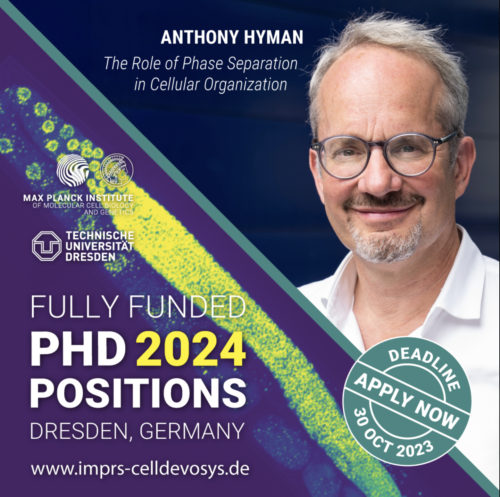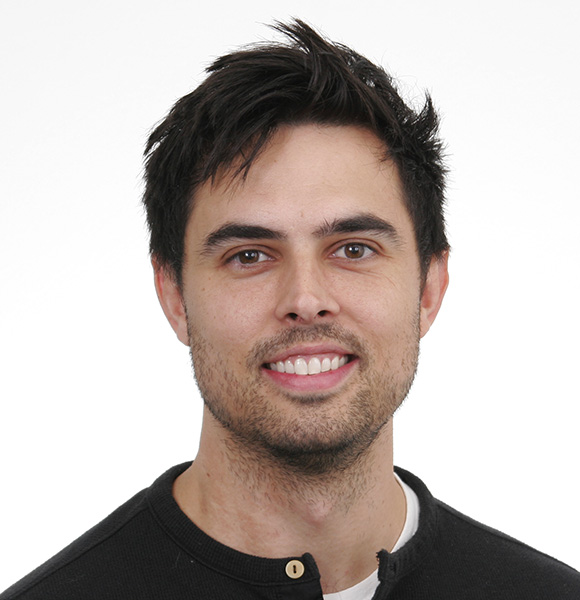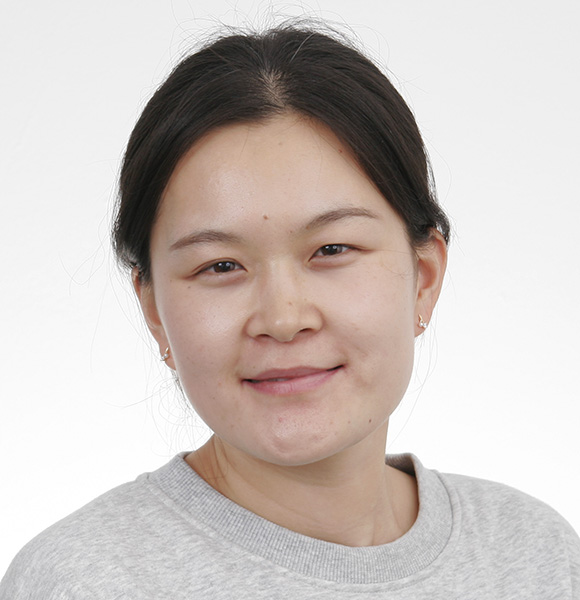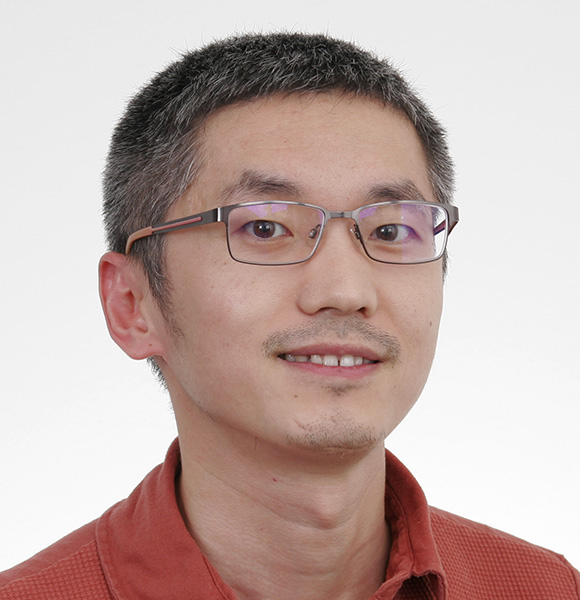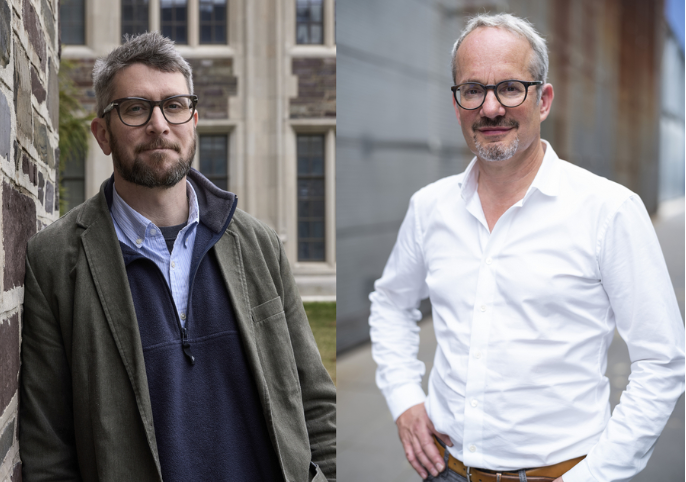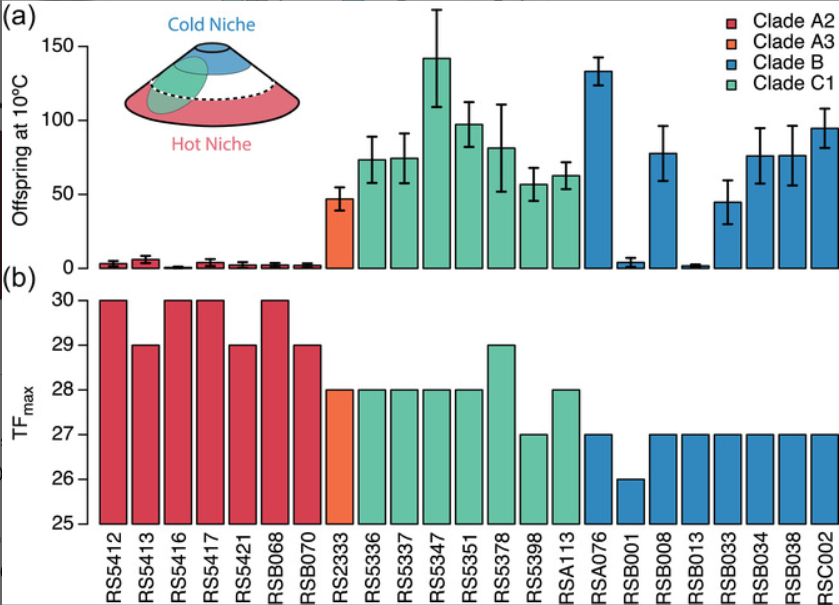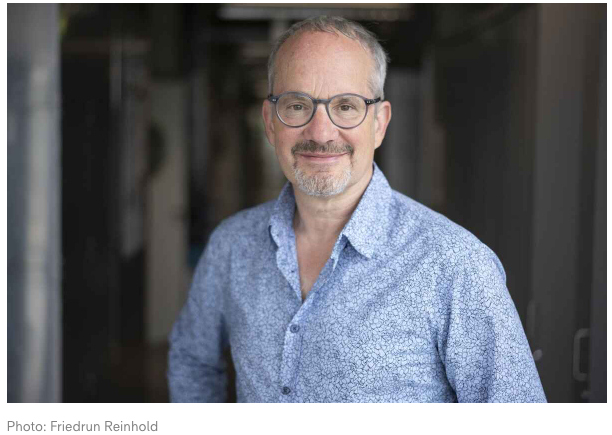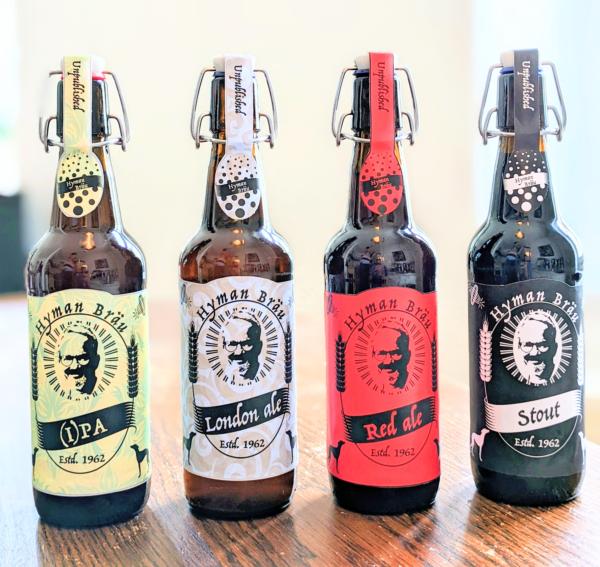the original article is posted here
19th Wiley Prize in Biomedical Sciences laureates share their discovery stories
The 19th Annual Wiley Prize in Biomedical Sciences celebrated a breakthrough in cell biology: how membrane-less cellular compartments are formed. The existence of membrane-less organelles, often called bodies or puncta, has been known for a long time, but what exactly they represented and how they were formed was not known. This problem was solved by a physicist, Clifford Brangwynne, a cell biologist, Anthony Hyman, and a chemist, Michael Rosen. Each, synergistically, made groundbreaking contributions to the discovery that membrane-less organelles are liquid–liquid phase-separated entities. The two independent discoveries leading to the principle that multivalent low-affinity interactions between selected sets of macromolecules, some containing intrinsically disordered regions, formed a molecular condensate with unique dynamic properties, gave birth to the large, blossoming field of biomolecular condensates. The implications of those findings have influenced almost all further research of intracellular processes, including RAS signaling, immune synapses, DNA repair, transcriptional activation, and the functions of nuclear pores, the nucleolus and centrosomes. In this perspective article, the laureates of the award take us on their personal and professional trip that led to their scientific discoveries. Their stories are a celebration of the interdisciplinary essence of Natural Sciences and the potential unlocked when scientists from different fields work together to solve mysteries.
CHANCE AND PREPARATION ON THE ROAD TO MULTIVALENCY-DRIVEN LIQUID–LIQUID PHASE SEPARATION
Michael K. Rosen
Department of Biophysics, Howard Hughes Medical Institute, UT Southwestern Medical Center, Dallas, TX 75390, USA
I was thrilled and honored to share the 2020 Wiley Prize with my friends and colleagues, Cliff Brangwynne and Tony Hyman, and I am pleased to have the opportunity to explain how my lab came upon multivalency-driven liquid–liquid phase separation and intersected with Cliff and Tony.
When I was an undergraduate majoring in chemistry and chemical engineering at the University of Michigan, I had the good fortune to spend a summer doing research in the lab of Dr. Barnett Rosenberg. Rosenberg was a biophysicist at Michigan State University known for discovery of cis-Diamino-dichloro-platinum, cisplatin, one of the first effective anticancer drugs. Rosenberg knew my parents through the small Jewish community in my hometown of East Lansing, Michigan, where MSU is located. When he learned that I would be spending the summer after my sophomore year back at home, he offered to host me in his lab. Rosenberg’s discovery of cisplatin was one of serendipity, observation, and careful experimentation. He, the manager of his lab (Loretta VanCamp) and a graduate student (Thomas Krigas), had been studying the effects of electric current on bacteria, and noticed that when they used one particular electrode—one made of platinum—bacteria stopped dividing and became filamentous. Rather than discontinuing use of this problematic electrode as a technical artifact, Rosenberg and colleagues became intrigued. They sought to understand these unexpected effects, recognizing that analogous inhibition of cancer cell division might lead to a chemotherapeutic agent. Eventually, they tracked the inhibitory activity down to cis-Diamino-dichloro-platinum released into solution from the electrode. The rest, as they say, is history. In reflecting on his discovery, Rosenberg often repeated Pasteur’s quote that “chance favors the prepared mind” and encouraged those in his lab to keep an eye out for the unexpected and consider it as a potential source of discovery. This philosophy from early in my scientific career stuck with me, and I believe was instrumental in my lab’s contribution to the discovery of multivalency-driven liquid–liquid phase separation as a general principle in cell organization.
For many years after its founding in 1996, my lab had used primarily nuclear magnetic resonance (NMR) spectroscopy and biochemistry to study signaling pathways that control the actin cytoskeleton. We were particularly interested in pathways that connect Rho family GTPases, through proteins in the Wiskott-Aldrich syndrome protein (WASP) family to the actin nucleating machine, the Arp2/3 complex. In 2008, we published a paper showing that WASPs bind and activate the Arp2/3 complex with 2:1 stoichiometry, and thus, dimerization of WASPs dramatically increases their affinity (∼100-fold) for Arp2/3 complex because of avidity.1 Shae Padrick, then a postdoc in the lab, drove this work and recognized that this mechanism implied that multimeric assemblies of many WASP molecules should activate even better than dimers because of statistical effects. So, we began considering molecules/systems that might oligomerize WASPs. One protein that quickly came to mind was the well-known WASP ligand, Nck. This adaptor protein is composed of an SH2 domain, which binds phosphotyrosine, and three SH3 domains, which bind proline rich motifs (PRMs), connected by flexible linkers. The WASP family member, N-WASP, has a long disordered loop enriched in proline residues, which contains approximately nine PRMs. We intuited that three SH3 domains binding to nine PRMs should enable oligomerization. But the system seemed likely to produce a large distribution of interconverting species with different stoichiometries and conformations. Coming from structural biology, which typically focuses on discrete oligomers, it was unclear how to think about or study such a collection.
The problem began to take a manageable shape in the summer of 2008, when two students in my lab, Pilong Li and Hui-Chun Cheng, attended the q-bio Summer School in quantitative biology at Los Alamos National Laboratories. There, they heard a seminar that described computational modeling of sol-gel-phase transitions of multivalent particle systems—the sharp transition from small oligomers to system-spanning networks that occurs when a threshold fractional binding is achieved (think about the nearly instantaneous solidification of an acrylamide solution as it polymerizes to form an SDS PAGE gel). Recognizing the parallel between multivalent particles and Nck/N-WASP, Pilong and Hui-Chun returned to UTSW bubbling with excitement. We now had a theoretical framework grounded in polymer chemistry to begin to understand N-WASP oligomerization, and Pilong began modeling the system in this light. The problem also became vastly simpler. It was no longer one of trying to understand the “structure” of a complex distribution of interconverting species, but rather of identifying the concentrations needed for a sol-gel transition and characterizing the functional differences between the two states.
With this frame of mind, in the fall of 2008, Hui-Chun Cheng started mixing Nck and N-WASP. She found that at concentrations above ∼30 μM, the solutions immediately became cloudy when the two proteins were combined. Initially, we assumed that they had formed a large polymer, which had precipitated like the only other polymers we were familiar with, insoluble aggregates of unfolded proteins. As an NMR lab often working with highly concentrated protein solutions, we had frequently seen such behavior in samples as they aged. To remove the precipitate, Hui-Chun did as we had always done, and centrifuged it, expecting to see the typical white pellet at the bottom of the Eppendorf tube. The solution indeed clarified upon centrifugation. But to our surprise, there was no white pellet. It was as though the precipitate had disappeared. Yet, if Hui-Chun shook the tube, the cloudiness returned. She could repeat this process of clearing and shaking over and over, and always observed the same behavior. So, whatever caused the cloudiness was still present in the sample, but somehow we were unable to collect it by centrifugation. This was an active topic of speculation in the lab for several days, and we considered increasingly exotic explanations, for example, a precipitate that was destroyed by the force of centrifugation.
Eventually, we decided to look at the solution under a microscope, hoping for a clue. And there, we had our “aha” moment, as we found that there was no precipitate at all, but rather a solution filled with micron-sized liquid droplets, resembling oil suspended in water. We quickly realized that (a) such droplets would scatter light and thus explained the cloudiness of the solution, and (b) the total volume of the droplets must have been miniscule given their sizes and thus even if collected by centrifugation would be too small and too transparent to observe at the bottom of a column of clear solution. This initiated an incredibly exciting period in the lab, as we characterized the droplets and sought to understand their formation. We found that they appeared sharply with small increases in protein concentration and could be reversed by dilution, suggesting a phase transition. We also found that the proteins were highly concentrated in them, roughly 100-fold, which got us thinking about how they might influence actin nucleation through the WASP-Arp2/3 pathway.
In time—and this took us a couple of years and a number of additional observations and insightful considerations by my student Salman Banani to really grasp—we came to understand our system as reflecting the combination of two energetically coupled physical processes known for polymers since the 1940s. First, multivalent entities, such as multidomain macromolecules, can assemble into large oligomers when combined with multivalent ligands. Second, as polymers become less soluble as they become longer, this assembly inherently decreases the solubility of the molecules, and can ultimately drive their phase separation. The phase that forms is often liquid due to the dynamics of the molecules and their rapid rates of association and dissociation. The molecules are highly concentrated in the second phase, which can sometimes drive a sol-gel transition within them.
Polymer chemistry suggested not only how phase separation might occur, but also how it might be regulated. That is, polymer chemistry had established that higher valence of a molecule—more sites through which it can interact with a partner—promotes greater oligomerization. Since oligomerization begets phase separation, higher valence should thus promote phase separation. In the case of Nck and N-WASP, the SH2 domain of Nck was known to bind many proteins that contain multiple sites of tyrosine phosphorylation (pTyr). We reasoned that such a protein, by arraying multiple Nck molecules on a common scaffold, could effectively increase the SH3 valence of Nck and enhance phase separation in the presence of N-WASP. One poly-pTyr protein, the adhesion receptor nephrin, had been characterized and connected to Nck by my postdoctoral advisor, the late Tony Pawson. In fact, well before our observation of phase separation, Tony and I had discussed the possibility that the nephrin-Nck system might produce N-WASP oligomers. To test this idea, another student in my lab, Sudeep Banjade, examined the ability of the tyrosine phosphorylated nephrin intracellular tail to alter phase separation of Nck/N-WASP. As we had imagined, he found that phospho-nephrin does enhance phase separation in a manner dependent on the number of pTyr sites. A few years later, in a wonderful collaboration with Ron Vale’s lab at UCSF, my postdoc Jon Ditlev and Ron’s postdoc Xiaolei Su were able to show kinase-mediated assembly and phosphatase-mediated disassembly of an analogous system in tens of seconds, illustrating how changes in valence could alter liquid-liquid phase separation (LLPS) in real time.2
Sudeep also performed another critical set of experiments that showed a functional consequence of phase separation. He did this by holding N-WASP at a fixed concentration and adding an N-WASP fragment containing only the proline-rich region but lacking the Arp2/3 binding element. This fragment could induce LLPS of the Nck/N-WASP in solution, but could not itself stimulate actin assembly. At low concentrations, below the LLPS threshold, the fragment had no effect on Arp2/3-mediated actin assembly. But as soon as the threshold was crossed, actin assembly rates increased, and continued to increase as more fragment was added and more N-WASP was drawn into phase separated droplets. We were eventually able to get beautiful fluorescence microscopy images from these assays showing that much of the actin assembly occurred within the droplets. Thus, phase separation was a mechanism to enhance the specific activity of N-WASP toward the Arp2/3 complex. The final piece of the puzzle was put into place by another graduate student, Soyeon Kim, who showed that coexpression of engineered polySH3 and polyPRM proteins in mammalian cells produced spherical droplets with properties and dependencies akin to those we had generated biochemically. Thus, multivalency-driven LLPS could also occur in cells. Together we had identified a mechanism of droplet formation, multivalency-driven phase separation; a means of regulating formation, phosphotyrosine-mediated (and thus kinase/phosphatase-mediated) changes in valence; and a functional consequence of formation, enhanced actin assembly.
Although my research program was focused primarily on biophysics and biochemistry, during the course of this work, we were well aware of the signaling and cell biological literature on actin regulatory systems. Various groups had shown that when WASP proteins and their ligands such as Nck initiate actin assembly, they often do so through forming concentrated puncta on cellular membranes. When examined in live cells, the puncta showed rapid exchange of molecules with the cytoplasm. Thus, having observed a mechanism to concentrate Nck and N-WASP in vitro, we began to think that perhaps, the biochemical process we had observed could underlie formation of these cellular structures. Most importantly, since many signaling proteins are multivalent and often have multivalent ligands, we thought that the process was likely relevant to other signaling systems as well. In this extrapolation, I must credit my first department chair, Jim Rothman at the Memorial Sloan-Kettering Cancer Center, whose frequent exhortations to everyone in our department to seek generality put me always on the lookout for principles of one system that could be applied to others. Jim, I thought, would be excited by these ideas.
Then one morning in the summer of 2009 a postdoc in my lab, Chi Pak, who was always up on the latest literature, walked into my office with a smile on his face. He was holding the now-seminal paper from Cliff and Tony showing that P granules in the Caenorhabditis elegans embryo are formed by LLPS.3 And he asked “I wonder if these guys are seeing in cells what we are seeing biochemically”? We had never heard of P granules, or for that matter most of the biomolecular condensates known at the time, but this paper launched a literature search in the lab on these structures, and, in particular, for their components. We found that like the signaling clusters, these other compartments also contained numerous multidomain proteins—for example, multidomain RNA binding proteins–which often had multivalent ligands, for example, RNA. This led us to think that perhaps, the phenomena we were observing were not limited to signaling at membranes, but could underlie these three-dimensional liquid compartments as well. An even greater generality.
In the end, we cast a large (and very speculative!) net in our initial paper on this work, suggesting multivalency-driven LLPS as a potential mechanism to form many different membraneless compartments, both at membranes and in the cytosol.4 We suggested that such a process could enable switch-like control of biological assembly, which, by creating compartments with distinct chemical and physical properties, could enable tight regulation of biochemical and biological functions. It is now clear that this was far too simplistic a description of the many known biomolecular condensates. Some form by LLPS, others likely do not. Some are large enough to clearly be called a separate phase, others contain sufficiently few molecules that they are probably best considered more as large oligomers. Many, perhaps most, natural condensates are multiphasic structures with complex internal organization; few if any are isotropic. The material properties of condensates vary widely, from dynamic liquids to immobile solids. There are many instantiations of biological multivalency that we were not thinking of in our initial studies of actin signaling, most prominently intrinsically disordered protein regions but also nucleic acids, chromatin and even synaptic vesicles. Despite these complexities, I hope that the framework we suggested provided valuable initial directions for the new field of biological phase separation. I also hope that Dr. Rosenberg, who passed away in 2009, would be pleased to know that his student from so many years ago, and his grand-students, would also run with an unexpected observation and prepared minds to help chart new directions in science.
ACKNOWLEDGMENTS
Mike Rosen: I thank all of my many mentors, whose advice on how to approach science was critical to putting me on the path to phase separation. I also thank the many trainees I have had the privilege to work with over the years. Their hard work and insights were essential to all of the discoveries we have made. My colleagues at the memorial Sloan-Kettering Cancer Center and UT Southwestern Medical Center created collegial and stimulating intellectual environments that foster discovery, to our great benefit. I thank the numerous funding agencies who have made our work on actin regulation and phase separation possible, including the Howard Hughes Medical Institute, the National Institutes of Health, the National Science Foundation, the Paul G. Allen Foundation and the Welch Foundation. I thank the Chilton family, whose support through the Mar Nell and F. Andrew Bell Chair has been invaluable in enabling me to follow my nose in new and exciting directions. Finally, I thank my wife, Yuh Min Chook, and sons Samuel and Saul for their love, support and patience, which have provided the foundation for all of my scientific adventures.
FINDING MY WAY TO LIVING MATTER
Clifford Brangwynne
Department of Chemical and Biological Engineering, Princeton University, Princeton, New Jersey 08544, USA
Princeton Institute for the Science and Technology of Materials, Princeton University, Princeton, New Jersey 08544, USA
Howard Hughes Medical Institute, Princeton University, Princeton, New Jersey 08544, USA
cbrangwy@princeton.edu
I am always fascinated by stories of scientific discovery, how the combination of good luck, preparation, and curiosity collide to bring forth the new and unexpected. The history of science is full of these stories, and it is fun to look back on my own journey. It is also a great honor to be awarded the Wiley Prize with Tony Hyman and Mike Rosen, for work elucidating how phase transitions cause biomolecules to assemble into large scale membrane-less organelles or condensates. It is hard to believe that it has been 13 years since Tony and I published our 2009 Science paper on P granule condensation—so much has happened since those early days of our field. But, of course, my personal story begins much earlier than that.
I grew up in the Boston area, in a tight-knit working-class family fully of plumbers, painters, electricians, and nurses. Although neither of my parents had gone to college, they valued education, and nurtured my love for learning. But there were no chemistry sets in my house, I was not on any math team—there were certainly zero indications that I would become a scientist. In fact, my scholastic progress was touch-and-go, with some significant distractions, especially early in high school, when the only thing that I seemed to be connecting with was Spanish—a love for languages that grew when I spent a summer with a volunteer program in Ecuador. I did love to read, and got a job at the local Barnes and Noble bookstore, where I read books while pretending to stock the shelves. Probably, the first glimmer of my interest in science (aside from freshman earth science, with an “F” on my report card next to the teacher’s note: “shows interest in the subject”), was in my minor obsession with popular books on the mysteries of quantum physics—the Tao of Physics and Schrodinger’s Cat, were two that particularly caught my attention. Something magical was happening down there at the molecular level, and I wanted to know more.
Despite mixed high school grades, I managed to get into the Humanities College at Carnegie Mellon, mostly because of my interest in Spanish. But science was already starting to beckon. I took Intro Cell Biology and found it interesting, but it was mostly memorization of molecules and processes (“Purple Martians Are Tall = Prophase/Metaphase/Anaphase/Telophase”), presented as a series of “just so” stories, rather than a mechanistic dissection based on principles of physics and chemistry. Nevertheless, when a teaching assistant named Vivek Abraham showed me his movies of cell migration, I was awestruck—watching those cells ooze around the coverslip was just so cool, and I immediately signed up to work with Vivek and his mentor Fred Lanni.
But the linearity of that nascent path into biology was disrupted, with a seed planted several years earlier. In high school, I had gone to a party hosted by one of my Barnes and Noble coworkers, whose roommate ended up giving me a ride home. The roommate was a PhD student in the Materials Science and Engineering (MSE) Department at MIT, and the whole ride he told me all about the field, how everything around us is some material, and every single item in that car was engineered by a material scientist to have the right properties and function. So, when I saw that CMU was offering an Intro MSE course that second semester of my freshman year, I registered. The class had a lab where we poured 1000C molten aluminum alloys into little crucibles, and then studied how the crystals formed. The atoms, with only local information about their neighbors, new when and how to snap themselves into place, in a process that could be described using mathematical formalisms based on thermodynamics. I was hooked, and decided on an MSE major, minoring in physics, even while I continued to work with Vivek, on cell migration.
The idea of taking courses in one field, and then devoting significant time to laboratory research in completely different field, seems crazy and I am not sure why I thought that was ok. I do remember asking a few of my professors, and they thought that materials science and cell biology could be an interesting mix. For a long time, it did not feel like a mix, but more like parallel, nonintersecting interests. When I talked to the biologists (including at the first big conference I attended as an undergraduate, the 1997 ASCB meeting), they did not know anything about materials or how it could be related to biology, and the materials people did not know anything at all about biology.
As I continued to pursue these divergent interests into my sophomore year, I came across an article written by Harvard’s Don Ingber describing his concept of Cellular Tensegrity—the idea that biopolymer filaments scaffold living cells through a dynamic force balance, with microtubules under compression and actin filaments under tension. I wrote to Don, typing out a formal letter (we did have email but it seemed more likely he would read an actual letter) in which I asked if I could join his lab the next summer. I had decided to take a year off of college—I think it was mostly because I missed Latin America—and I thought I could first work in Don’s lab before departing with enough money saved up for the trip. (As an undergraduate advisor at Princeton, I often tell the students the obvious, which my mother certainly made clear at the time—it is probably not a good idea to take a year off in the middle of college, even though it worked out for me, and was actually one of the greatest years of my life!).
When Don wrote back and invited me to join his lab that summer, I was thrilled, and figured I would spend 2 months working and saving up, and then head south for my big adventure. But my time in the Ingber lab was just so magical, that I did not want to leave. I worked closely with Kit Parker, a new postdoc in the lab who became a valued mentor. Kit is a big tough southerner, an army reservist (who later served multiple tours of duty in Afghanistan, all while starting his lab and then getting tenure at Harvard), and presented a striking counterpoint to my skinny, long-haired, “hobo intellectual” appearance. We were using a micropatterning approach that had recently been developed with George Whitesides. We would plate cells onto these little micropatterned islands, and they would come down and spread out to assume the shape of the island. In the course of these experiments, I made my first scientific discovery: when two or more cells landed on the same island, some cell types would actually spread out and self-organize into persistently rotating migratory ensembles—we called it the Yin Yang, because that symbol is precisely what they looked like (people recently rechristened that effect as “Coherent Angular Motion”). What was exciting about this, was that it was an emergent phenomenon, something that only happens when several cells interact in particular ways—essentially a minimal model for tissue self-organization.
As the summer of 1998 turned into Fall and then Winter, I stayed on in Don’s lab. I finally bought a one-way plane ticket to Honduras, and spend that next Spring wandering around Central America (mostly El Salvador) and hitchhiking back up through Mexico and the United States. I learned a lot in that chaotic and beautiful adventure, in the raw spirituality of the trip—for example, about being comfortable with being uncomfortable (would I catch a ride? Would I be stuck in the rain all day? Where was I even going?)—that proved to be helpful in my scientific career, but that is a story for another day. Eventually, I got back to Boston that summer and returned to my work in Don’s lab. My mother was right, because I did not really want to go back to finish college. But Don and Kit convinced me that if I wanted to pursue a career in science, I would first have to do that.
Kit was the one who introduced me to Dave Weitz, and after wrapping up my last two years at CMU, I returned to Harvard to do my PhD in Dave’s lab. Dave is a real pioneer in the field of soft condensed matter, essentially the physics of squishy materials. The focus of most of the materials science work at CMU was on hard materials (like steel), but Dave worked on the type of soft materials that are most like the stuff of cells and tissues. In fact, Dave was just become interesting in biology, and therefore, it was the perfect place to train on the fundamental physics of soft matter, while continuing to nurture my love for biology. My PhD work was focused on the microtubule cytoskeleton—thinking about microtubules as little calibrated beams that could be used to extract information about the mechanical forces and nonequilibrium (e.g., ATP-dependent) fluctuation dynamics within living cells. But it was an incredibly diverse group, with my fellow lab members studying systems ranging from microfluidic double emulsions to colloidal crystals and gels to soot aggregation.
In the summer of 2006, as I was nearing completion of my PhD, I took the famous physiology course at the Marine Biological Laboratory (MBL), which at the time was led by Tim Mitchison and Ron Vale. This was a truly amazing and eye-opening scientific experience—a high-energy, action packed science summer camp, and I lapped it all up. Taking the physiology course made me even more certain that I wanted to do a full dive into cell biology for my postdoc. With my wanderlust still going strong, I started looking at labs in Europe, and reached out to Tony, who I had met at the MBL. Tony had been working primarily in the early C. elegans embryo, which was a powerful system where so much interesting biology takes place. Moreover, the Max Planck Institute for Cell Biology and Genetics (MPI-CBG) was a relatively new and dynamic institution with a collegial and collaborative culture, and it was closely linked to the group of Frank Julicher at the MPI for the Physics of Complex Systems. And I found Dresden’s rich and complex history fascinating, so I signed on.
Tony and I discussed project ideas, particularly around the role of cortical and cytoplasmic flows in driving the first asymmetric division in the newly fertilized embryo. I started to read some papers in this area, and learned about these structures called P granules, large-scale assemblies of many thousands of RNA and protein molecules. P granules start out evenly distributed throughout the C. elegans embryo, but end up localizing to just one side, and upon cell division only that posterior daughter cell—the first germ cell—contains P granules. When I read up on how P granules segregate to the posterior, I found that the proposed mechanism was cytoplasmic flow—the idea was that P granules were carried into the posterior by a stream of posterior-directed cytoplasm. The problem with this concept was that since cytoplasm is essentially incompressible, if some of it gets carried into the posterior, some of it would necessarily have to cycles back out of the posterior. So, something else had to be going on, and I wrote a Helen Hay Whitney Fellowship proposal to figure out what that something else might be.
Fortunately, there was a junior group leader down the hall from Tony’s lab, Christian Eckmann, who had already generated a stable worm strain containing a bright GFP-tagged PGL1, a key P granule protein. So, when I showed up in Tony’s lab the summer of 2007, I was able to hit the ground running. By the following Spring, we had used confocal imaging and particle tracking approaches to figure out that cytoplasmic flow does not cause P granule segregation. Instead, there is a spatiotemporal regulation of P granule stability, with P granules on one side of the embryo shrinking until they disappear, and P granules in the posterior growing. I developed some simple aggregation simulations, and was trying to dissect surface versus bulk attachment models, but we were not yet thinking about them as liquids (although one of my early group meeting presentations slides describes the possibility of a P granule representing an “unstructured glob”).
Tony, Frank Julicher, and I went back to the MBL the summer of 2008, to teach in the physiology course. It was there that the MBL magic happened, as it has so many times in the last century. Together with one of the students in the course, David Courson, we had taken some movies of two P granules fusing, and they looked “just like a liquid droplet.” I remember standing outside of Loeb lab, discussing this idea with several people, and the excitement just kept growing. It was one of those moments when everything suddenly falls into place. The dynamic growth and shrinkage we had measured in Dresden suddenly made sense. All of the things that I had learned in materials science and soft matter physics instantly became useful. My undergrad courses on “Phase Relations” and “Physical Chemistry of Macromolecules” had walked us through the basics of Polymer Physics and Flory Huggins theory, which continues to be a powerful conceptual framework for the condensate field. Ideas from colloid physics, surface tension, viscosity, and droplet coalescence dynamics, which I had been bathed in during my PhD in Dave’s lab, suddenly became urgently needed. Looking back at my presentation slides from those days reminds me of what a watershed moment this was for me personally—when suddenly, these different streams of my intellectual development finally collided, in a new alchemy.
We published the paper on P granule liquid condensation in 2009, and suggested that such phase transitions might be a very general mechanism in cells, although we had no idea if other liquid-like condensates were in cells. I decided to look into this, going back to the MBL that following summer to work in the lab of Tim Mitchison. With a wonderful trip to Joe Gall’s lab at the Carnegie—spending the day getting hands on training with Joe is an experience that I treasure—Tim helped get me started working with the frog oocyte system, which contains a very large nucleus containing hundreds of nucleoli. Nucleoli are perhaps the most interesting membrane-less bodies, and despite having been observed for nearly two centuries, are still highly mysterious. In a series of experiments, we were able to show that nucleoli exhibited many of the same liquid-like features that we had found in P granules, and the size distribution and other aspects of these nucleoli suggested they represent an emulsion of liquid-like condensates5.
It is interesting how much the MBL represents a strong thread running through my own personal story. It has been a touchstone for me since that first summer of 2006, and I spend whatever time I can there, and have also had the chance to work at the MBL with many other leaders of the condensate field, including Mike Rosen and Amy Gladfelter. What is absolutely amazing to me is that pioneering MBL scientists from the early 1900s, from EE Just and Victor Heilbrunn, to Roger Arliner Young and EB Wilson, were asking many of the same questions we are today, about the physicochemical properties of the cytoplasm. We were amazed to discover that EB Wilson gave a lecture at the MBL in 1898, in which he said “The living protoplasm… is a mixture of liquids, in the form of a fine emulsion consisting of a continuous substance in which are suspended drops…”. One of the highlights of my career was giving an MBL Friday Evening Lecture last summer (https://m.mbl.edu/default/device/text/video/detail?feed=youtube&id=DkhFiW5n7rQ), where I explored the fascinating historical arc of our understanding of these states of living matter.
I started up my own lab at Princeton in 2011, on the heels of our initial P granule and nucleolus discoveries, but with so much left to be figured out. I have been incredibly fortunate to have many tremendously talented students and postdocs come through my lab, who played critical roles in helping launch this field, many of whom have now gone on to start their own groups and make new discoveries about different aspects of phase transitions throughout the cell. I am particularly proud of our work on the biophysics of nucleolar assembly and function, and the emerging links between condensates and intracellular mechanics. But I am also an engineer, and like to remind people about the transformative power of technologies like GFP, RNAi, Super-resolution Microscopy, and CRISPR. As Sydney Brenner said, “Progress in science depends on new techniques, new discoveries, and new ideas, probably in that order”. So I am also fortunate to have so many people come through my lab who share my interest in developing technologies to probe and control the biomolecular and biophysical determinants of intracellular phase transitions.
As the field has grown, I have been thrilled to see the convergence of not only soft matter physics and cell biology, but also an increasingly diverse set of disciplines, including structural biology, developmental biology, genetics, neurodegeneration, cancer, and chemical biology, to name just a few. Looking forward, I am also excited about the potential for controlling biomolecular phase transitions, in applications ranging from therapeutic interventions to bioengineering synthetic organelles. The ability to truly harness living matter, in the same way we harness steel, silicon, and copper, has immeasurable potential for benefiting society, both for treating devastating diseases, and for creating the next generation of transformative technologies.
ACKNOWLEDGEMENTS
Cliff Brangwynne: I thank all the amazing scientists, students, colleagues, and mentors that I have had over the years. I particularly would like to underscore the critical role of Vivek Abraham, Fred Lanni, Kit Parker, Don Ingber, Dave Weitz, Frank Julicher, and Tony Hyman. The opportunity to work with and learn from these and other scientists, at CMU, Harvard, MPI-CBG and MPI-PKS, the MBL, and Princeton, has been truly life-changing. I’m also grateful for funding support over the years, with particular thanks to the Helen Hay Whitney Foundation, HFSP, NSF, NIH, and HHMI.Finally, I would like to thank my family, whose love and support have made this scientific adventure both possible and worthwhile.




